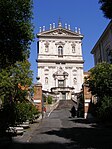Santi Quirico e Giulitta
18th-century Roman Catholic church buildings in ItalyRoman Catholic churches completed in 1733Titular churches

The Roman Catholic titular church of Santi Quirico e Giulitta (Saints Quiricus and Julietta) in Rome is named after a son and mother who were martyred in 304 AD in Tarsus. The church is located in central Rome behind the Forum of Augustus. The address is: Via di Tor de’ Conti 31/A, 00184. Today the church is administered by the Third Order of Saint Francis. The feast of Sts Quiricus and Julitta is celebrated on 16 June.
Excerpt from the Wikipedia article Santi Quirico e Giulitta (License: CC BY-SA 3.0, Authors, Images).Santi Quirico e Giulitta
Via Tor de' Conti, Rome Municipio Roma I
Geographical coordinates (GPS) Address External links Nearby Places Show on map
Geographical coordinates (GPS)
| Latitude | Longitude |
|---|---|
| N 41.894 ° | E 12.4876 ° |
Address
Chiesa dei Santi Quirico e Giulitta
Via Tor de' Conti
00184 Rome, Municipio Roma I
Lazio, Italy
Open on Google Maps









